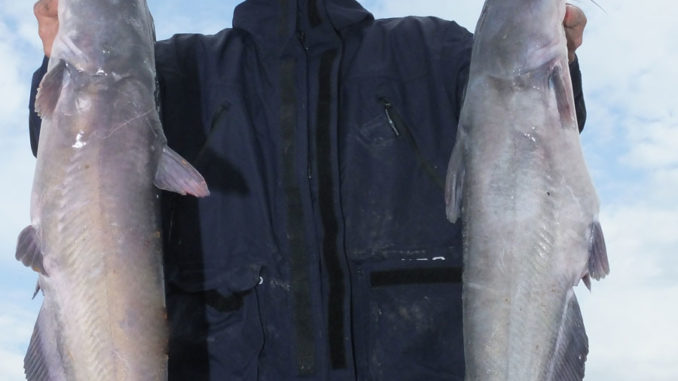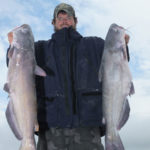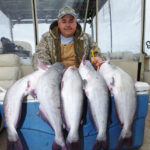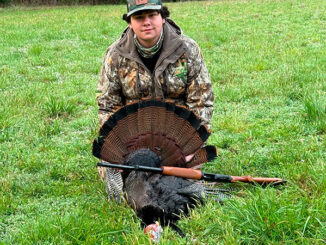
Lake Monticello’s big blue catfish turn on in winter, giving anglers a chance to do battle with trophy class fish.
If you wanting to get your string stretched to the limit by a big catfish in cold weather, you’ll be hard pressed to do better than South Carolna’s Lake Monticello. It is an real wintertime catfish destination for a couple of very good reasons.
First, the lake is teeming with blue catfish, the cats that get outlandishly huge and often gorge on multiple food sources during cold weather. This binge-eating mode serves anglers well and provides great winter action when many species seem to shut down. The consistent top-end size of Lake Monticello’s blues rivals any and exceeds most other lakes in the state.
Guide William Attaway of Pomaria targets these big catfish throughout the year.
“Catching huge catfish at Lake Monticello is possible anytime, but I think winter is the prime time to hook up with big blues,” Attaway said. “Monticello also has a lot of catfish in the 15- to 30-pound class that are very active during cold weather, providing excellent action for quality fish. Monticello can be fickle at times, but the winter catfishing is not just about hooking a huge-catfish-or go-bust fishery. We have excellent days with good action and quality fish in the 15- to 30-pound and larger class.”
As in any fishery, anglers have different ways to reach the same end result, and in February, drift fishing, specifically controlled drift fishing, and fishing from anchored positions are both very productive on Monticello. Small targets holding large numbers of fish can be effectively fished using both techniques.
It’s more of an angler’s personal preference, but specific techniques tend to make each more productive.
Attaway has developed his drift-fishing technique into a highly productive tactic.
“I want to cover as much area as I can but fish it very effectively,” he said. “I target specific targets and work each area thoroughly. I’ll typically graph areas such as points, humps, ledges and flats near much-deeper water before fishing an area. Then, I plot the best drift to keep my baits in front of fish I’ve marked.”
Attaway fishes from a pontoon boat, and his electric motor provides the power to move the boat along a well-defined path. He does not randomly drift; he has a specific area he wants to cover, and keeping his boat and baits in the right position is a key to his success. He prefers to drift at about .4 to .6 miles per hour, and he will typically will drift with six to eight rods to cover a wide swath of water.
“Drift-fishing gives me the mobility to fish large areas. It’s not unusual to mark a lot of forage and fish in a broad, general area,” he said. “I am looking for that area with active, biting fish. If I present my baits at the right speed and in the places fish are marked, but I don’t get bites, I keep moving to find fish in other places. I may return to a good-looking spot later in the day and try it again, and it’s not unusual to return and find catfish be biting like crazy. The best technique for me is to effectively fish as much area as I can and a side benefit is we’ll typically pickup occasional catfish while searching for a hot spot.”
Attaway said he’ll literally track his drift on the graph, and when he hits a productive area, he can repeat the drift. That’s very important if the fish are in isolated areas: on the top of humps or just off to the side of a ledge. He said a long drift over a series of humps and valleys will produce consistent action.
Attaway typically has better success in the lower half of the 6,700-acre lake because of the warm-water discharge into the lake from the nearby SCE&G nuclear facility.
“The shad seem to be drawn in larger numbers to the lower end because of warmer water temperatures, and the catfish follow the shad,” Attaway said. “I’ll catch fish throughout he lake during the winter, but the lower end is consistent.”
Guide Justin Whiteside of Rock Hill fishes Monticello year-round and has refined his technique there to primarily anchor-fishing.
“I often find on Lake Monticello that the blues will get into a narrow bite zone,” Whiteside said. “When they do, anchoring and casting baits to specific targets increases the number of bites I’ll get.”
When Whiteside sets anchor on his roomy pontoon, it’s not as simple as dropping a brick over the side and letting the wind move the boat until the line tightens. He will double anchor on a precise target to fish effectively.
“During cold weather, I’ll mark fish on specific places on various bottom features,” he said. “Catfish tend to have preferences, such as congregating on the downwind side of a hump. But the specific locations and depths change daily. Windy and cloudy conditions sometimes have catfish feeding shallow, while bright, cold, windless days on this clear lake often push forage and fish a bit deeper.”
Whiteside said deep water is a relative concept at Lake Monticello. The lake has water in excess of 100 feet deep, but typically the fish are not often found that deep even in the winter.
“Generally, the catfish will be from 20 to 60 feet deep,” he said. “With a graph, it’s not hard to quickly figure it out. I’ll usually graph a couple of potential places before setting up to get the feel for the depth pattern. At times, catfish will be deeper at Monticello, and I’ll fish where fish are found, but my normal starting point is the 20- to 60-foot range.”
Whiteside said the specific bait used is always crucial, and as a general rule, he favors larger baits for big fish.
“But it’s not a hard and fast rule,” he said. “At times, catfish get finicky about what they eat, and smaller baits can be better. I like the concept that elephants will eat peanuts, so I typically use assorted sizes until I see a daily trend. I’ve caught huge blues here on quarter-sized baits.”
Whiteside uses live bait more frequently in the winter at Monticello than at other times.
“I think the cold water temperatures can occasionally make even blue catfish lethargic, so I’ll use live bait to charge them up,” he said. “Live baits will swim, creating both vibration and movement — often keys to triggering a strike. My favorite for cold-weather catfish at Monticello is dollar bill-sized gizzard shad. Other good choices include white perch and blueback herring. I often use a trailing No. 6 treble hook as a stringer hook on live bait as well as big cut bait offerings.”
Whiteside said the time of day for the best bite can be important on Monticello, but it’s difficult to predict in advance.
“Air temperature may be very cold, but I’ll be on the lake early in case it’s an early morning bite; I don’t want to miss that window of opportunity,” he said. “The fish will bite on and off during the day, but the morning bite is usually pretty consistent, and that gets the day off to a good start. In low-light conditions, fish are usually shallower early, and (they) get progressively deeper as the sun gets higher. ”
Attaway said when water is being pumped in or out of the lake, the bite can be better.
“Other than wind, no natural current flow exists here,” he said. “I think the fish bite best is when water is being pumped, because that creates moving water, triggering a good bite. We’ll catch fish without moving water, but it can really turn the blues on. I think during the pumping process, baitfish gets churned, and that triggers catfish to feed. ”
Attaway and Whiteside have another common denominator in terms of what it takes to produce a good catch of catfish on Monticello, specifically patience.
Attaway said wintertime fishing on Monticello has the potential for great rewards, but it is often a process of searching for active fish, eliminating unproductive areas and staying on the hunt until catfish are caught.
“Sometimes, finding catfish occurs quickly, but on some days, we have to work out a pattern,” he said. “I keep working different places, varying types of baits, the speed of the drift and the depths I fish.”
Whiteside said when anchoring, he will give a spot an hour or sometimes longer if the setup looks really promising.
“I don’t anchor unless I feel confident based on what is shown on the graph,” he said. “Usually, we don’t have to wait long when I put the bait right in front of the fish, but like any fishing, it can be a process. It takes a few minutes to graph and set up on what are often small targets, but in the long run, we’ll end up spending a lot more time catching fish.”
DESTINATION INFORMATION
HOW TO GET THERE — Lake Monticello is just west of SC 215 and just east of the Broad River in Fairfield County, near Jenkinsville. Two public boat ramps service the lake, one off SC 215 on the east side of the lake and one on CR 99 on the lake’s northwest corner.
WHEN TO GO — The dead of winter is an excellent time to fish Monticello, especially February, when blue catfish utilize multiple species of baitfish
BEST TECHNIQUES — Drift of slow-troll cut or live baits around humps, ledges and points, or find fish on your depth finder and anchor up, fan-casting baits to different depths. The lower end of the lake is usually more productive, and the 20- to 40-foot depth range is a good place to start.
FISHING INFO/GUIDES — William Attaway, 803-924-0587; Justin Whiteside, Whiteside Whiskers Guide Service, 803-417-0070. See also Guides and Charters in Classifieds.
ACCOMMODATIONS — America’s Best Value Inn, WInnsboro, 803-635-1447; Fairfield Motel, 803-635-3458.
MAPS — Kingfisher Maps, 800-326-0257, www.kfmaps.com; Delorme’s SC Atlas & Gazetteer, 800-511-2459, www.delorme.com.






